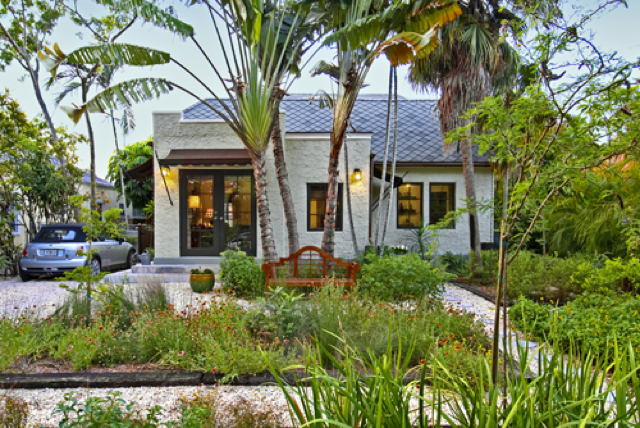
Image Credit: Marice Chael
Image Credit: Marice Chael View of the existing home from the back yard. This attached screen porch was deconstructed and demolished to make way for the 2-story concrete block addition that will double the size of the home.
Image Credit: Marice Chael Spraying soy-based polyurethane foam insulation under the floors above the dirt crawlspace was a dirty job. But it was an efficient way to tighten up this portion of the house.
Image Credit: Marice' Chael A mighty big crane was needed to place the structural ridge (flitch beam) at the back of the house where the two-story addition is located.
Image Credit: Marice Chael The back 2-story addition under construction. Plenty of rebar in the concrete block walls to handle hurricanes that seem to frequent south Florida.
Image Credit: Marice Chael Work ongoing 2nd floor interior. Note the exposed ridge, rafters and roof deck. All of the insulation is topside. The roof deck is plywood; finish T&G board stock will complete the interior roof assembly.
Image Credit: Marice Chael In the existing wood-framed section of the home, window openings are structurally-reinforced before hurricane-resistant window are installed.
Image Credit: Marice Chael A small loft with a parapet cleverly conceals HVAC equipment in an accessible location within the conditioned portion of the home.
Image Credit: Marice' Chael The reclaimed transom door and skylight from an attic find, an original glass kitchen cabinet, allows light to filter to the bedroom from the stairs beyond.
Image Credit: Marice Chael Although completely gutted during renovation, the floor plan of the living room did not change.
Image Credit: Marice Chael The dining room/library occupies part of the ground floor of the new addition. The coffered ceiling enlarges the room while providing space crucial to keeping HVAC ducts in conditioned space and the wall of custom cabinetry with a reading nook fits well with this room being the "study hall" for the Chael-Dover family.
Image Credit: Marice Chael This is the reading nook in the dining area. The low ceiling results from accommodating the stairs above.
Image Credit: Marice Chael The original kitchen was expanded in the of area the exposed rafters. A new pantry and stackable washer/dryer are accommodated in the existing kitchen floor area. Altlhough still compact in size, the new kitchen allows for a modest eat-in counter/ work area.
Image Credit: Marice Chael The new bedroom, although compact in size, has a generous cathedral ceiling. Kahrs oak flooring ties to the color pallette of original house.
Image Credit: Marice Chael This is the bathroom for the master bedroom on the 2nd floor of the addition. Notice how the walls of the bathroom are actually just open-top partitions to connect this space to the airiness of the cathedral ceiling and bring in more natural light.
Image Credit: Marice Chael Stairs create a dramatic narrow space open to the cathedral ceiling.
Image Credit: Marice Chael The small area at the top of the stairs leading to the bedroom is captured for a small work desk.
Image Credit: Carlos Morales, Carpeluz Photography The 2nd floor master bedroom suite is quite private and open at the same time. The balcony to the right in this photo faces north to the rear of the lot, looking out over the garden and salt lap pool.
Image Credit: Marice Chael Masons built the garden retaining walls with Oolitic Limestone from the foundation excavation — a great example of responsible material-sourcing and jobsite-waste reduction.
Image Credit: Marice' Chael Rain chains and copper gutters are part of the attention to detail and style of the local architectural vernacular.
Image Credit: Marice Chael A portion of the PV system can be seen on the south face of the roof of the 2-story addition.
Image Credit: Marice Chael The completed project from the back yard showing the new salt lap pool and the just-planted native trees and shrubs.
Image Credit: Marice Chael Cross-section at kitchen - this is the existing structure (wood-framed receiving the gut rehab).
Image Credit: Marice Chael Through section for the addition - concrete block wall.
Image Credit: Marice Chael Watercolor elevations of the existing original exterior (foreground) and the new two-story addition.
Image Credit: Marice Chael Site plan for the Chael-Dover Cottage
Image Credit: Marice Chael Image Credit: Toshi Woudenberg
This South Florida LEED for Homes pilot project incorporates full-spectrum green while honoring the local architectural vernacular
Historic preservation meets green building at the residential scale in the addition and renovation of our cottage in South Miami. Located in the Cambridge Lawns Historic District, the cottage was part of the LEED for Homes pilot program and achieved Gold Level certification while maintaining the character and scale of the surrounding historic district.
A slice of south Florida architectural history
Cambridge Lawns, South Miami’s first historic district, is a lush oak, palm and pine oasis located between Miller Road and the canal front at 57th St, and between Brewer Park on 63rd Avenue and 60th Avenue. A collection of modest Tudor and Mediterranean style cottages, the neighborhood was originally platted in 1925 by Auburn-educated builder William J. McLeod. The original plan for the neighborhood included streets named after universities such as Harvard, Princeton, Yale, and Auburn, perhaps as a nod to the University of Miami, about a mile away.
From 1926–28 McLeod built thirty cottages that barely reached 1,000 square feet, all of which still remain today. The cottages were wood-framed and clad with stucco. While being consistent in scale, the decorative details vary, with some cottages having pointed or rounded arched openings, steep roofs, stylized wood brackets, chimneys and timber details. While most of the cottages have been altered over the years reflecting generations of residents who have left their mark, there is still a consistent and distinct character to Cambridge Lawns, and a stark contrast to the ranch houses subsequently built in the surrounding area.
Chael cottage history
Our cottage was no exception, having gone through various additions and changes over the years. The original Tudor 980 square foot cottage had a large living/dining area with hard wood floors, a single bathroom, and a small kitchen area. It still had its original interior doors with hardware, bathroom light fixtures and medicine cabinet. The original kitchen had been altered, and had a layman tile counter and wood tongue and groove planks for cabinets. On the exterior, the original wood windows had been replaced with bronze-tinted aluminum frame windows. Also, a handyman-built screened porch, wood deck, laundry room and small efficiency had been added to the rear in the 1970’s. Tudor details of the house remained, however, such as the steep roof, soffit details, and jerkin-head gable-ends.
Goals: go green, honor character
The goals of the renovation/addition were twofold: to maintain the scale and character of the historic district, while implementing sustainable building practices. The detailing and character of the original cottage guided all interventions and design decisions.
To consolidate as small a footprint as possible on the land, the additional 1000 square feet of living area was split into two levels situated to the rear of the existing cottage, leaving the original cottage largely intact. The addition matched the original structure’s steep roof, eave detail, and stucco texture. The steep roof of the existing cottage effectively screens the addition from the street.
Green can mean efficient interior design
Making the house as compact as possible required carefully thought out spaces for their maximum efficiency. The main needs were for an additional bedroom and bath, and a modestly larger kitchen. To open the views of the ground floor to the rear garden, new rooms were incorporated at ground level. A dining room/library, joined by a family room/guest room, connect to the original house. A stair off the dining connects to a small work area, master bedroom and bath. Additional kitchen area was secured by demolishing the exterior laundry shed and reclaiming that area for interior use. A stackable washer and dryer closet was incorporated in the new kitchen design. In addition, being in the LEED for Homes pilot challenged us to find innovative ways to implement the requirements of the LEED criteria, while staying true to the original design of the house.
Victor Dover and I collaborated on the design and served as architects and owner-builders. Project Manager Tony Garcia served as Chael Cooper’s main liaison with LEED-Homes verifier Eric Martin, of the Florida Solar Energy Center. Other members of the project team included engineer Gerry de Marco, and environmental consultant John Kiefer from E-3 Building Systems.
A green location
One inherent green feature of the cottage has nothing to do with building systems, however, but with its urban location. Many early twentieth century developments such as Cambridge Lawns benefit from compact design and proximity to neighborhood amenities. These factors help reduce the need to travel by car. In fact, the daily office commute is just a mile and a half, making it practical to carpool or bike to work. The proximity of transit service, both bus and rail, also has a major impact in car use (and by extension energy use). Daily trips to schools are done by metro and walking.
A green start with deconstruction
Initial site work on the cottage involved demolition of the 1970’s era additions, as well as the construction of a silt fence at the front of the property to prevent runoff. Demolition debris was organized and recycled; old appliances, central air, and light fixtures were donated for reuse. Throughout construction, recycling building debris and keeping waste to a minimum was a challenge, as recycling construction material was practically nonexistent at the time, and proved to be one of the areas where the project struggled to meet acceptable green standards.
The existing interior of the house was carefully gutted to make way for new hurricane resistant casement windows, chosen for their period appropriateness and ability to maximize natural air flow. New electrical lines and high efficiency wall insulation were installed. The structure was also improved, as many of the original wood studs and beams had termite and water damage. After comparative analysis, new exterior walls were built of concrete block wall, the normative building method locally.
Focus on Energy
The dual goals of increased energy efficiency and reduced energy consumption were major themes in the design of the building systems. The original house was built without mechanical air conditioning, and addressed circulation by using passive cooling devices such as fans, cross ventilation, and an elevated living space. The necessity of the house to ‘breathe’ was facilitated by the building envelope which was not sealed, and relied on hot air escaping the house through its un-insulated attic, and fresh air entering from the windows and crawl space. As the HVAC systems of the house were to be updated to two-zone high efficiency central units, the energy systems of the house had to balance passive and active strategies. We decided to seal the existing house using closed cell blown insulation in the crawl space and attic, while the perimeter of windows and exterior doors were also sealed and weatherized. Rigid insulation was applied directly to the new concrete block walls in the addition, and the new roof was insulated with 3.5” rigid insulated panels.
Two new high SEER central AC units were installed, along with programmable thermostats. Together with a high efficiency clothes washer, energy star rated lighting fixtures and fans, and a solar powered water heater. The Energy Star-rated exterior lights are outfitted with solar sensors that only turn on at night. Efforts were also made to supply the house with solar power; however the payback of the investment made it unrealistic at the time. As an alternative, the electrical system was designed to allow for a future connection to roof mounted photovoltaic panels. With these strategies combined, the energy usage of the refurbished house is approximately 50% more efficient per square foot than the original.
Passive cooling strategies were implemented using native landscaping and canvas awnings on the south and east facades. On cooler months when no air conditioning is required, the new casement windows and high efficiency ceiling fans allow for maximum natural cross ventilation at all habitable rooms.
Efforts were also made to supply the house with solar power; however the payback of the investment made it unrealistic at the time. As an alternative, the electrical system was designed to allow for a future connection to roof mounted photovoltaic panels. With these strategies combined, the energy usage of the refurbished house is approximately 50% more efficient per square foot than the original. The house is in the process of being fitted with solar photovoltaic panels, and once completed, it is anticipated that the panels will provide about 50% of the electric power demand.
Green materials
Other measures were taken to address interior air quality as well. The insulation previously described was formaldehyde free, as were the kitchen cabinets, while the interior paints and stains were no-VOC. The forced-air HVAC system includes both high-MERV filtration and [BLANK] mechanical ventilation.
Inside the house, more efforts were made to use recycled and reclaimed materials. All original doors and fixtures were reused in the house, as was an original kitchen cabinet door that was discovered in the attic. A reclaimed transom oak door complete with original hardware was purchased from an antique salvage yard and installed in the master bedroom. Perhaps the most peculiar recycled material used in the house was the EcoStar diamond roof shingles, made partially from recycled baby diaper lining. In other cases, where finished wood was desired but not available in recycled form, the certification of the Forestry Stewardship Council (FSC) was essential in ensuring that old growth forests were protected and all wood resources were properly harvested. All finished wood, including kitchen cabinets, moulding, trim, baseboard, stair railing, doors, and new wood flooring was FSC certified.
Local craftsmen and trades performed all work, and it was important to highlight local craft as much as possible. In order to utilize space efficiently, storage niches and shelving were installed throughout the house. Custom wall to ceiling bookcases were incorporated in the dining room, and room transitions include paneling with shelving. Experienced carpenters custom turned the legs for the kitchen counters, as well as carved banister ends for the stair FSC wood railings. Exposed roof rafter tabs and shelf brackets were custom made. Metalworkers created the diamond balcony panels inspired by the diamond panes in Tudor windows.
Water efficiency is especially important in South Florida
Water efficiency was another area of special concern in the renovation. Dual flush low-flow toilets were installed, as were low flow adaptors for the faucets and showerheads. On the exterior, native drought tolerant vegetation was planted, and rainwater barrels were strategically located around the house to collect roof runoff and store it for use when necessary. Recycled Kentucky bourbon barrels were used for rainwater harvesting channeled by copper gutters and rain chains. Other recycling measures taken in the garden included using oolitic limestone excavated on-site for a small retaining wall at the front of the property, as well as recycled railroad ties for use in creating various planting beds. In lieu of sod, pea gravel was installed in the front yard between planting beds and in the driveway; grey river rock was installed in the rear yard between the new salt lap pool and vegetation, providing for maximum site infiltration.
Green gardens
Both the foursquare garden and the English garden served as inspiration for the south facing streetside garden. The idea of the order provided by the railroad tie beds coupled with the aesthetic of the English informal cottage garden seemed an appropriate visual foreground to the historic cottage. There, home-grown produce and native wildflowers and shrubs coexist. Native flowers such as tickseed, wild sage, lilies, milkweed, blue porter and blanket flower are interspersed with tomatoes, peppers, okra, and squash. Banana, papayas grown from seed, and Key lime were also planted. (The compost oftentimes yields volunteer produce.) Native trees planted in the garden include mahogany, gumbo limbo, seagrape, buttonwood, geiger, and green stopper. Palms include Florida thatch palm and blue-stem palmetto. Shrubs and groundcover include firebush, hedges of necklace pod, Jamaica caper, muhly grass and coontie. Butterflies and bees are regulars in the garden, and it is gratifying to see the cycle of the seasons in the flowering of the shrubs, fruit and wildflowers.
Long-term green
It is our hope that our house will evolve with us. Several years from now, our kids will move out to go to college and eventually marry. Their rooms can then become a workout room, additional office, or even an artist studio. As we age and can no longer to climb the stairs to our bedroom, we can convert the upstairs to an externally accessible accessory dwelling, inhabiting one of the bedrooms below, as when we first moved in. That would be just fine.
Weekly Newsletter
Get building science and energy efficiency advice, plus special offers, in your inbox.
Lessons Learned
We have been in our "new" home now for several years since the gut rehab and addition. Lots of people ask us what lessons we learned or what we would do differently if we could do it all over again. Honestly, the only thing we would change would be the rain barrels. We get enough rain here that going with a much-larger capacity cistern, one that could be used for irrigation and indoor functions such as supplying toilets, would have been a better approach.
And, admittedly, it would have been nice to get our PV system in place to move to LEED for Homes Platinum, before the 1-year rating window, but the Gold rating makes this no less a great place to live.
General Specs and Team
| Location: | South Miami, FL |
|---|---|
| Bedrooms: | 3 |
| Bathrooms: | 2 |
| Living Space: | 1984 |
| Cost: | 200 |
| Additional Notes: | The cost for this project includes gut renovation of existing 1000 conditioned space, adding 1000 new conditioned space, and landscaping. |
Design: Marice Chael & Victor Dover, Chael, Cooper & Associates Project Management: Tony Garcia, Chael, Cooper & Associates Environmental Consultant: John Keifer, E3 Building Sciences LEED for Homes verifier: Eric Martin, Florida Solar Energy Center Landscape Design: Claude Roatta, Action Theory Landscaping
Construction
Existing House:
Foundation: poured concrete; unfinished crawl space; closed-cell polyurethane spray foam under existing floor (R-22)
Walls: 2x4, 24 in. o.c.; kraft-faced formaldehyde-free fiberglass batts (R-11)
Roof: 2x6, 24 in. o.c.; sprayed closed-cell polyurethane foam; unvented (R-22)
Windows: impact-resistant single-pane (SHGC, .53; U factor, .94)
Garage: none
Addition:
Foundation: poured concrete
Walls: CMU w/ XPS foam and stucco on exterior R-value: 4.1
Roof: SIPs,T&G fir roof deck over exposed rafters (unvented, R- 19)
Windows: impact-resistant single-pane (SHGC, .53; U factor, .94)
Energy Specs
Heating/cooling: Lennox 2- and 3-ton condensers (15 and 16 SEER)
Water heating: 80-gallon Rheem solar storage tank with top electric element
Water Efficiency
- low-flow toilets: Toto Dualmax
- Energy Star dishwasher: GE
- Energy Star clotheswasher: LG
- Recycled bourbon barrels to capture and store rainwater for irrigation (approximately 480 gal.)
- Use of native plants (drought-tolerant)
Indoor Air Quality
- Low/no VOC paint Sherwin Williams Harmony
- all HVAC ducts in conditioned space
- entryway shoe removal & storage
- Formaldehyde-free insulation
- No wall-to-wall carpet
- Formaldehyde-free adhesives used in cabinets
Green Materials and Resource Efficiency
- FSC-certified wood products throughout project
- Recycled content roof tiles
- Stone from foundation excavation used for retaining walls
- construction & demolition recovery percentage: 10% Construction diversion rate; 80% demolition/land clearing diversion rate
Alternate Energy Utilization
Certification
- LEED for Homes Gold (pilot)
- HERS Rating: 69

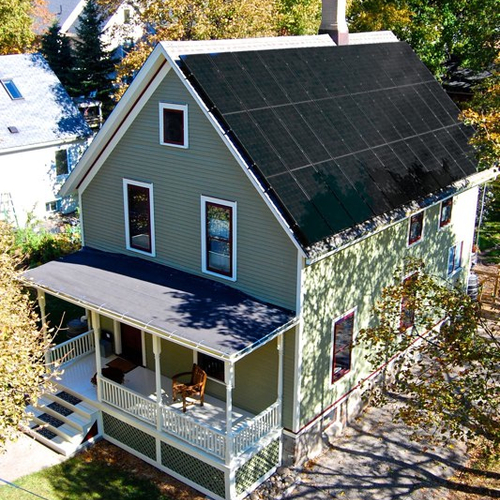
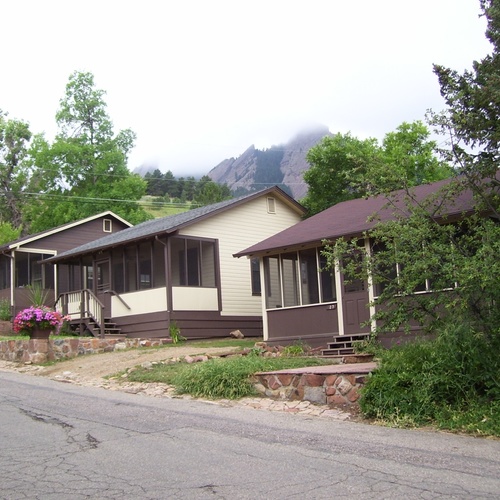
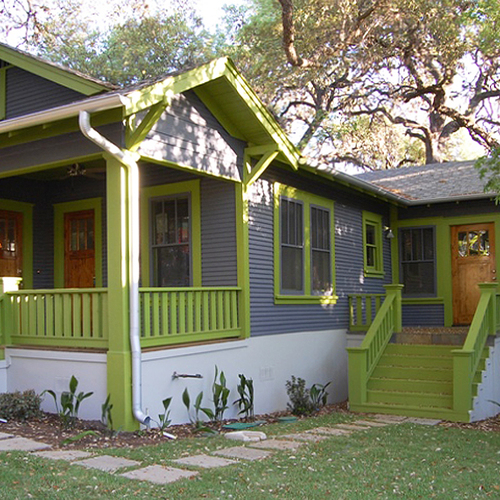
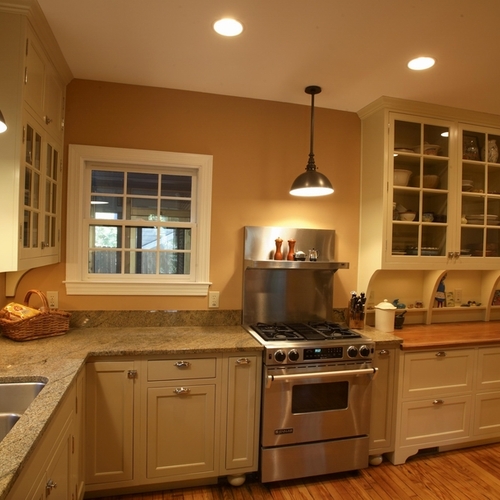






0 Comments
Log in or create an account to post a comment.
Sign up Log in